Programme Learning Outcomes
Getting started with Programme Learning Outcomes
Introduction to the Four-Stage Process
Staff are advised to follow an outcomes-based approach to education, that is to directly align the learning outcomes of a course of study (at the programme and modular level) to assessment tasks, their marking and feedback, and teaching and learning activities (QAA). We embed this approach in the LTA by promoting this 4-stage process to programme development. Here we focus on the Programme Learning Outcomes, the first of the stages.
See below for a diagram that explains the process.
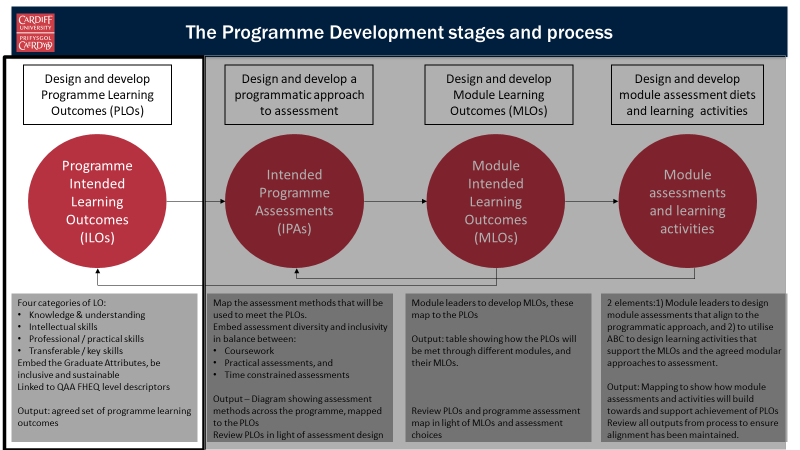
Another aspect of this page to be aware of is the Holistic Template for Programme Development. We’ll be filling it in in increments across the four pages as part of this process. It is available in its entirety in the Deeper dive.
What are Programme Learning Outcomes?
Learning outcomes are a clear, concise description of what a student should be able to demonstrate in terms of knowledge, understanding and behaviours at the end of a programme or module. Learning outcomes guide what and how we teach and assess, and therefore they should represent the core of what students learn. This process of alignment is called constructive alignment (Biggs, 1996) and is discussed further in the Deeper dive.
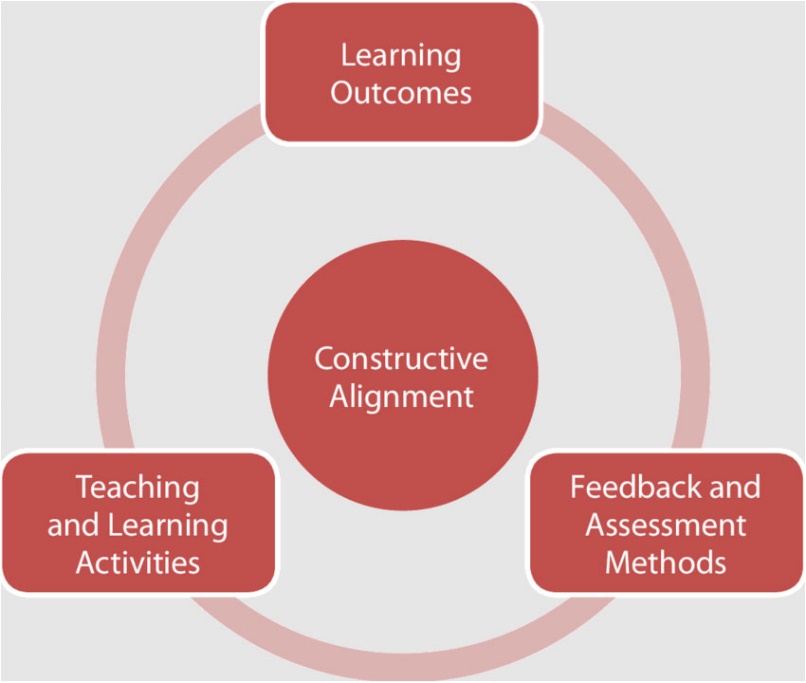
Constructive alignment and PLOs
Why are Learning Outcomes so important?
Learning Outcomes perform a number of crucial functions in the design, delivery and marketing of courses. They:
- clearly communicate expectations to learners;
- clearly communicate graduates’ skills to prospective employers;
- define coherent units of learning that can be further subdivided or modularized for classroom or for other delivery modes;
- define the type and depth of learning students are expected to achieve;
- provide an objective benchmark for formative, summative, and prior learning assessment;
- guide and organise the instructor and the learner.
In this toolkit we embrace ‘backward design’ – here we see the programme learning outcomes guiding a programmatic assessment approach. Module learning outcomes and module assessments are then engineered to support achievement of those assessment tasks, and by turn achieve the Programme Learning Outcomes, represented visually below:
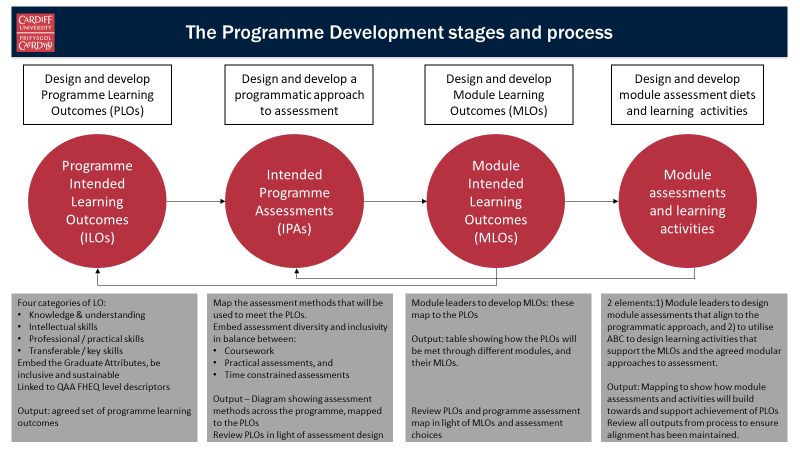
Programme and Module Learning Outcomes
Learning Outcomes are set at both programme and module level.
Programme Learning Outcomes describe what a student will be able to do (and become) as a result of their programme of study at Cardiff University. They will help students understand what is expected of them at the programme level. Hence, it is important that they are written FOR your students, that they are aligned to the assessments students will undertake (to allow students to demonstrate their achievement of the outcomes), and that they are not simply a list of ‘teaching intentions’. Programme learning outcomes need to be set at the level of the award, in line with FHEQ level descriptors and, where appropriate, be aligned with the attributes, skills, and abilities expected within that discipline, as defined in the relevant QAA Subject Benchmark Statements.
Similarly, module learning outcomes identify the smaller (more) discrete outcomes that a student will be expected to demonstrate their achievement of within an individual module. These also need to be (constructively) aligned to the module aim and assessment strategies.
The relationship between Programme and Module Learning Outcomes
The following infographic offers information on the differences and similarities between Programme and Module Learning Outcomes. VASCULAR refers to a progressive approach to writing Learning Outcomes proposed by Sally Brown: feel free to read this in order to develop your understanding further and contact the CLTA if you’d like to know more.
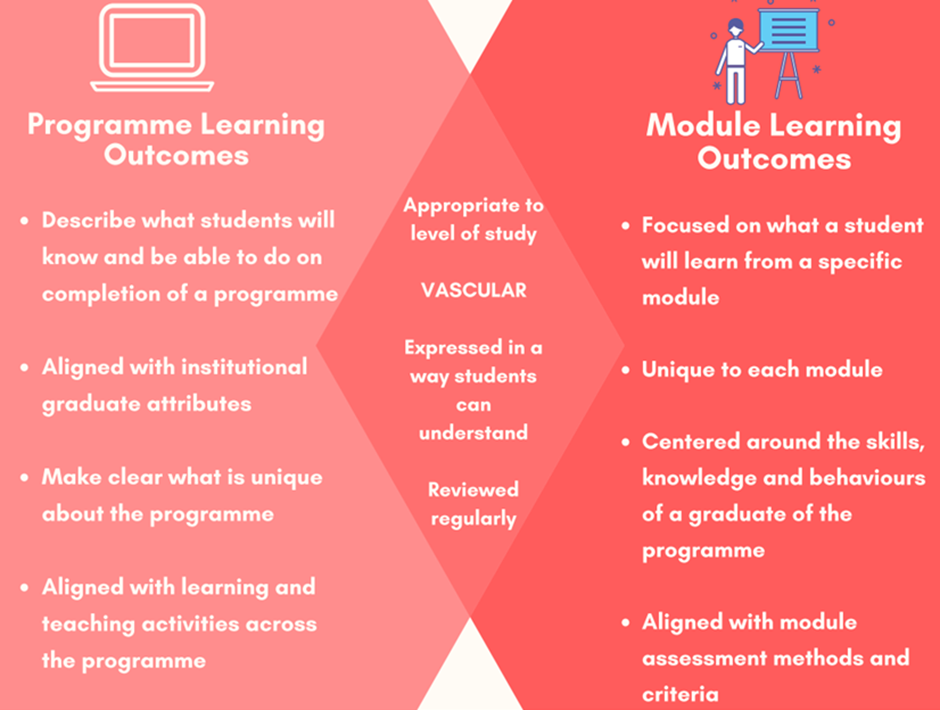
How to write PLOs
Categories of Learning Outcomes
As suggested in the CLTA Programme Development Process, and as required for Quality Assurance, good learning outcomes refer to a range of different ways of demonstrating achievement:
- Knowledge and Understanding (KU)
- Intellectual Skills (IS)
- Professional Practical Skills (PS)
- Transferable / Key Skills (KS)
Writing effective PLOs
To ensure that your learning outcomes are student focused, it can be useful to try and put yourself in the student’s shoes and to think about how you might respond to these as a student. Learning outcomes are normally made up of three elements.
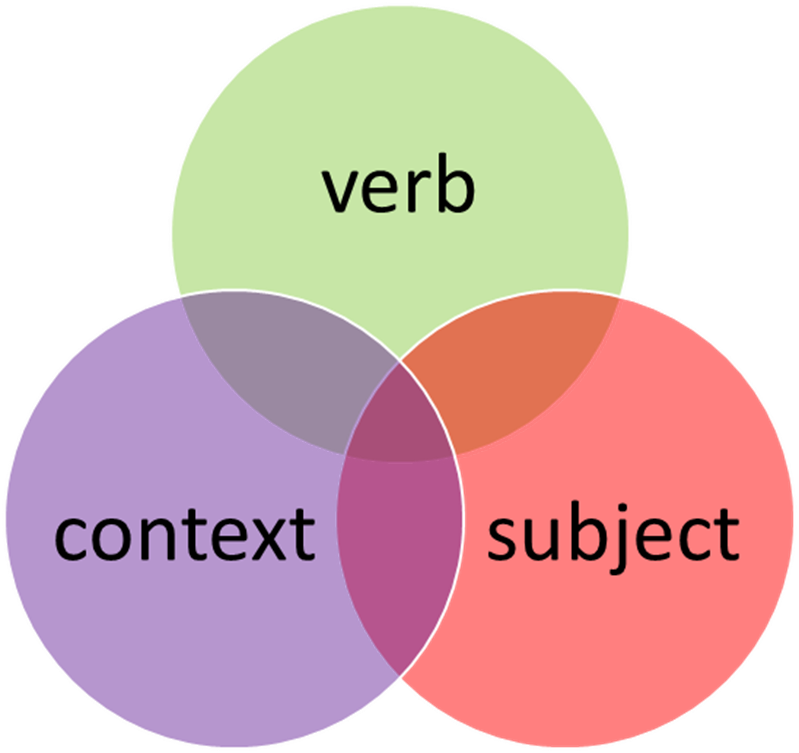
- A verb to define the specific action that students to demonstrate their learning.
- A subject, to specify the subject material you want the learning to cover.
- The context of the learning. While learning outcomes do not need to explicitly refer to particular methods of assessment, they should include an indication of the standard of the performance that will demonstrate that the defined learning has been achieved. It should therefore be clear what a student needs to learn/do to attain that learning outcome.
Let’s see that in practical terms:
- An action that can be verified empirically, by ‘the evidence of your eyes and ears’;
- A subject: the given;
- Performance criteria which contextualises the learning (may be implicit).
Examples:
- Analyse the relationship between the language of satire and literary form by the close examination of a selected number of eighteenth-century texts.
- Compile a research paper which encompasses a wide range of relevant methodologies and resources.
- Demonstrate a critical understanding of the technological aspects of imaging modalities, including the use of pharmacological agents, to assist with the procedures.
- Design and prepare a clear and coherently structured written presentation about the biography of a building or site.
- Demonstrate an in depth knowledge of implementing evidence based risk assessments, risk and crisis management plans, in collaboration with service users and carers and colleagues from inter-professional and interagency organisations.
Intended outcomes should always be assessable, so their wording needs to reflect the skills and behaviours students should be able to demonstrate on successful completion of the programme/module.
Categories of PLOs
Using the example of developing a programme in MSc Rocket Science drag and drop the Learning Outcome into one Graduate Attribute that you feel is best met by these programme outcomes. In reality there will be many more than one Graduate Attribute which may be relevant to each Learning Outcome, but this activity is for illustrative purposes, so pick what you believe is the most obvious fit.
Click here to play in full screen mode.
To do an alternative version in Word which can be read by a screenreader, click here.
Deeper dive
Share your feedback
Where next?
You are on page 1 of 4 of the 4-stage process for Programme Development.
The next pages are:
2) Programme Assessment
3) Module Learning Outcomes
4) Module Assessment
❗ It is strongly recommended if you are designing a new programme or undergoing revalidation that you explore the following pages as you build up your Quality documentation. They are in a fixed order:
Or you could return to Programme Development and visit the other pages another time.
